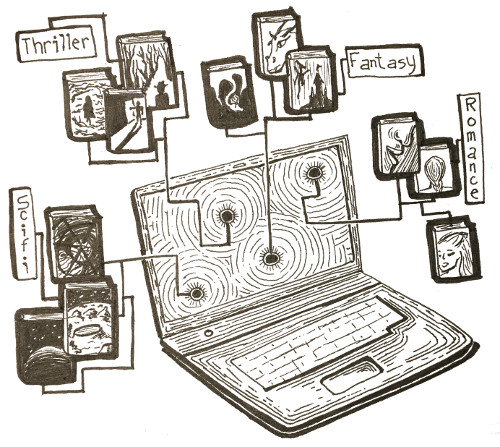The publishing world has long recognized the link between a book’s cover image and its genre. A quick glance at this compilation of cliché book covers will obliterate any doubts. There are no shortages of dragons to grace the covers of fantasy or shadowy figures for mysteries. People have come to accept and expect these trends. And now, so have computers.
Last year, Brian Kenji Iwana and Seiichi Uchida of Fukuoka, Japan’s Kyushu University created a computer program capable of sorting books into their genres using cover images as the only criterion. This type of program is called a Convolutional Neural Network (CNN) and uses a Deep Learning algorithm to allow the machine to continue learning as it’s exposed to more data.
This software program works on the same computer learning principle as Facebook’s facial recognition software program. The more tagged photos of someone’s face uploaded, the more data it has, and the better it can correctly suggest tags. Iwana and Uchida’s CNN has learned to sort 137,788 Amazon book cover images into twenty genres.
To someone like me, who knows nothing about computer science but a lot about science fiction, this story conjures visions of battles between robots and humankind. However, upon further research, this doesn’t seem to be the case (yet). What this does mean is that Iwana and Uchida’s CNN was able to learn a skill we already knew humans had. The team from Kyushu University was able to both confirm that book cover clichés are more than the ravings of book bloggers and that a machine could be sophisticated enough to perform such a seemingly objective task.
Due to crossovers between genres as well as less-detailed book cover images (such as solid colors), the CNN could outperform a human at the same task, however the computer was able to pair the book cover with its genre at a rate higher than chance. This means that the software works and can only be improved. Iwana and Uchida are already trying to incorporate the typeface of the book’s title as a criterion.
It may seem like this CNN means more to advances in computer science than in book publishing. That’s probably true, however, that doesn’t mean that the publishing industry can’t use this technology in areas such as marketing and market research.
Amazon is the top online bookseller, so running Iwana and Uchida’s CNN on their genre lists and comparing sales data could show connections between book covers and demand. This connection may seem like a stretch; however, an online shopper on Amazon can rarely leaf through the book due to digital rights and ends up making a decision based on reviews and the book’s cover. This gives the cover more weight in the buyer’s decision and therefore in sales.
Elizabeth Hughes, a fellow Ooligan Press student, has suggested the CNN’s potential as a self-check for publishers to make sure the cover fits current trends in the book’s genre before hitting the shelves. No adult reader likes picking up what they think is a thriller only to discover it’s YA fiction.
On the other hand, perhaps the CNN is revealing an uncomfortable truth. Have we finally stooped to mass-market media gimmicks just to sell another book? Has the content of the books become as cliché as the covers themselves? And if not, why don’t the covers speak to the diverse stories within?
Just as humans have coded this machine to learn on its own, the CNN in turn can help humans learn. Perhaps my human vs. robot reaction to this story was too separatist. And someone—anyone, human or machine—please find answers to my questions above.

